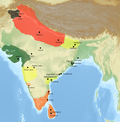Kalashoka. The Mahāsāṃghika nikāya developed into numerous sects which spread throughout ancient India. Some scholars think that the Mahāsāṃghika Vinaya (monastic...
61 KB (7,698 words) - 02:24, 7 November 2024
existed in the early Buddhist schools. The Sarvāstivāda, Kāśyapīya, Mahāsāṃghika, Ekavyāvahārika, Lokottaravāda, Bahuśrutīya, Prajñaptivāda, and Caitika...
28 KB (3,348 words) - 03:45, 1 November 2024
Tripiṭaka (section Mahāsāṃghika)
accepted as canonical by the Mahāsāṃghika school. The Theravādin Dīpavaṃsa, for example, records that the Mahāsāṃghikas had no abhidharma. However, other...
40 KB (4,119 words) - 23:39, 21 November 2024
from which the school derived its name Mahāsāṃghika. However, such popular explanations of Sthavira and Mahāsāṃghika are generally considered folk etymologies...
8 KB (918 words) - 12:25, 14 March 2024
Nikāyas (monastic groups, divisions), the Sthavira ("Elders"), and the Mahāsāṃghika ("Great Community"). This initial split occurred either during the reign...
45 KB (4,771 words) - 16:06, 25 October 2024
Devadatta (section Mahāsāṃghika Vinaya research)
generally agrees that the Mahāsāṃghika Vinaya is the oldest extant Buddhist Vinaya. According to Reginald Ray, the Mahāsāṃghika Vinaya mentions the figure...
18 KB (2,231 words) - 02:26, 7 November 2024
Ekavyāvahārika (category Mahāsāṃghika)
the Mahāsāṃghikas. The Ekavyāvahārikas, Gokulikas, and Lokottaravādins are the three groups that emerged from the first split in the Mahāsāṃghika sect...
5 KB (683 words) - 15:22, 21 October 2024
schools, the Mahāsāṃghika branch regarded the buddhas as being characterized primarily by their supramundane (lokottara) nature. The Mahāsāṃghikas advocated...
82 KB (8,633 words) - 16:40, 10 November 2024
with the Sthaviras do contain more rules than those of the Mahāsāṃghika Vinaya. The Mahāsāṃghika Prātimokṣa (list of rules) has 67 rules in the śaikṣa-dharma...
50 KB (6,110 words) - 08:25, 8 November 2024
Nikaya Buddhism (section In the Mahāsāṃghika branch)
Dharmaguptaka, which included a Bodhisattva Piṭaka and a Dhāraṇī Piṭaka. The Mahāsāṃghika nikāyas generally advocated the transcendental and supramundane nature...
10 KB (1,224 words) - 17:40, 24 October 2024
Caitika (category Mahāsāṃghika)
Caitikas branched off from the main Mahāsāṃghika school in the 1st or 2nd century BCE. Epigraphic evidence of the Mahāsāṃghikas in the Mathura region dates to...
13 KB (1,582 words) - 18:38, 1 November 2022
One of the few Mahāsāṃghika texts which survive, the Mahāvastu, is from this school. Another sub-sect which emerged from the Mahāsāṃghika was called the...
42 KB (4,307 words) - 22:19, 13 November 2024
The Mahāsāṃghika-vinaya (Chinese: 摩訶僧祇律; pinyin: Móhēsēngqílǜ; Wade–Giles: Mo-ho-seng-ch'i lü) (T. 1425), a Chinese translation of Mahāsāṃghika version...
25 KB (2,972 words) - 13:23, 18 October 2024
were available: the Dharmaguptaka Karmavācanā for ordination, and the Mahāsāṃghika Prātimokṣa for regulating the life of monks. After the translation of...
28 KB (3,385 words) - 04:53, 28 August 2024
Sarvāstivāda school, which was mainly in north India. Likewise, the Mahāsāṃghika groups also eventually split into different Sanghas. Originally, these...
246 KB (27,411 words) - 13:57, 21 November 2024
Kukkuṭika (category Mahāsāṃghika)
a copy of the Mahāsāṃghika vinaya from a monastery in Pāṭaliputra that he describes as "Mahāyāna". The Kukkuṭikas were a Mahāsāṃghika sect known to exist...
5 KB (679 words) - 01:50, 31 August 2022
Prajñaptivāda (category Mahāsāṃghika)
tradition to be in the early Mahāsāṃghika schools, and cites the Bahuśrutīyas and Prajñaptivādins as sub-sects of the Mahāsāṃghika that may have played an...
7 KB (849 words) - 02:24, 7 November 2024
monasticism and asceticism. The Mahāsāṃghika origin theory, which argues that Mahāyāna developed within the Mahāsāṃghika tradition. This is defended by...
150 KB (17,730 words) - 18:23, 14 November 2024
Luminous mind (section Mahāsāṃghika)
nothing of his entire body unpervaded by pure, bright awareness. The Mahāsāṃghikas also held that the mind’s nature (cittasvabhāva) is fundamentally pure...
31 KB (3,981 words) - 05:57, 2 September 2024
Emperor Ashoka, the Buddhist community split into two branches: the Mahāsāṃghika and the Sthaviravāda, each of which spread throughout India and split...
88 KB (9,637 words) - 14:15, 11 November 2024
that Dharma is limited to what was spoken by the historical Buddha. The Mahāsāṃghika and the Mūlasarvāstivāda considered both the Buddha's discourses and...
66 KB (7,686 words) - 19:06, 5 November 2024
Sthavira nikāya became influential in Western and South India while the Mahāsāṃghika branch became influential in Central and East India. Akira Hirakawa and...
92 KB (10,584 words) - 12:29, 20 November 2024
Early Buddhist texts (section Mahāsāṃghika sources)
sources. However, fewer Mahāsāṃghika texts have survived in comparison to Sthavira material. One important source for Mahāsāṃghika EBTs is the Mahāvastu...
47 KB (5,790 words) - 20:13, 29 September 2024
prātimokṣa codes are extant, including those contained in the Theravāda, Mahāsāṃghika, Mahīśāsaka, Dharmaguptaka, Sarvāstivāda and Mūlasarvāstivāda vinayas...
7 KB (874 words) - 13:48, 7 November 2024
traditions or Nikaya schools, including Theravāda, Sarvāstivāda and Mahāsāṃghika. The doctrine is found, for example, in 2nd century CE sources like the...
108 KB (12,475 words) - 19:10, 19 November 2024
Dharmakāya (section Mahāsāṃghika)
According to Guang Xing, two main aspects of the Buddha can be seen in Mahāsāṃghika teachings: the true Buddha who is omniscient and omnipotent, and the...
26 KB (3,131 words) - 14:31, 7 November 2024
reasonably good Sanskrit, sometimes with a Pali syntax, states Renou. The Mahāsāṃghika and Mahavastu, in their late Hinayana forms, used hybrid Sanskrit for...
288 KB (30,083 words) - 02:30, 20 November 2024
accepted as canonical by the Mahāsāṃghika school. The Theravādin Dīpavaṃsa, for example, records that the Mahāsāṃghikas had no abhidharma. However, other...
79 KB (9,945 words) - 13:09, 10 October 2024
among the early schools, at a minimum the Sarvāstivāda, Kāśyapīya, Mahāsāṃghika, and Dharmaguptaka had recensions of four of the five Prakrit/Sanskrit...
16 KB (2,025 words) - 11:24, 28 September 2024
Caitika schools of the Mahāsāṃghikas. Alex Wayman has outlined eleven points of complete agreement between the Mahāsāṃghikas and the Śrīmālā, along with...
8 KB (976 words) - 17:53, 4 March 2024

















